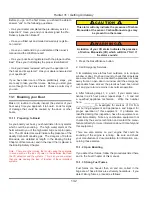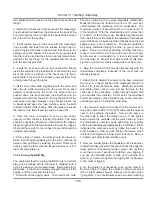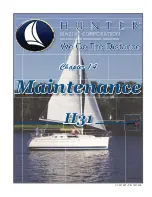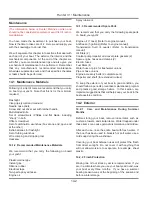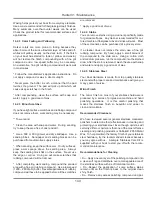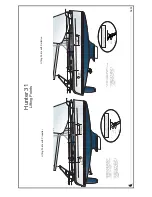
Hunter 31 • Maintenance
tings.
* Check and service batteries, tighten battery connec-
tions, and lubricate as needed.
At the end of this chapter, you will find a maintenance
schedule. It is important that you keep the manufactur-
er’s documentation for the components and follow the
maintenance schedules and procedures listed in that
literature. This information takes precedence over what
is supplied by the boat manufacturer.
14.6 Storage and Lifting
In most cases, the reason for storage is winter layup.
The information in this section is a general guide. Your
boat dealer or a competent boatyard should prepare your
boat for winter storage. If you are removing your boat
from the water for another reason, use the information in
this section as a guideline. Following the procedures in
this section helps to extend the life of your boat and its
equipment and simplifies re-commencing in the spring.
Indoor storage is beneficial if you are storing your boat in
a climate that produces ice and snow. However, the stor-
age building should be adequately ventilated, not tightly
closed. Ventilation, both around and throughout the boat,
is very important.
If you use outdoor storage facilities, cover your boat with
a canvas cover with provisions for ventilation to keep the
boat from “sweating.” Building a frame over the boat to
support the canvas will allow the passage of air around
the boat. The frame should be a few inches wider than
the boat so the canvas will clear the rails.
Before preparing your boat for winter storage, check the
condition of the boat and its systems and equipment.
Note any repairs needed. The need for other repairs may
become apparent during winterization. Make arrange-
ments to have the repairs completed.
14.6.1 Lifting Your Boat
Following are guidelines which will help prevent damage
to your boat as it is being lifted.
* Never hoist the boat with a greater than normal accu-
mulation of water in the bilge. Fuel and water tanks
should be empty.
* Place slings where indicated by the sling tags on the
gunwale. Proper location of the aft sling is critical. Lifting
aft of the station indicated may damage the propeller
shaft. Lifting forward of the station indicated, with the
sling under the exhaust outlets, may cause cracking
which is not covered by the warranty. Blocks or pads at
the chine corners will help keep pressure to a minimum
at this point.
* Disconnect the propeller shafts at the transmissions to
prevent damage to the transmission.
* Use flat, wide slings made of belting and spreader bars
long enough to keep pressure off the gunwale. Do not
use cable slings. Pressure by the slings on the gunwale
can cause severe gelcoat crazing or more serious hull
damage.
* The spreader bar at each sling should be as long as the
distance across the widest point the sling surrounds.
* Weight should be primarily distributed along the keel.
If a marine railway or platform is used, locate and adjust
the blocking to distribute the weight over several areas at
the intersection of stringers and bulkheads. The bunks
and/or blocks should match deadrise angle and provide
adequate support and stability.
* When lifting the boat, keep the bow higher than the
stern so the exhaust lines can drain. This will keep water
from running forward through the manifold and into the
engine itself where the water can become trapped.
Note: Keep the bow higher than the stern every time the boat
is lifted. Do not lift the stern to change a propeller. Doing so
can cause water to enter the engine. Engine failure is possible
if water enters the engine cylinders. This water can cause
hydrolock and bend the piston rods. Even a small amount of
water can cause rust or other damage.
14.6.3 Draining Your Boat
Your boat has bilge pumps for draining water from the
bilges. Some compartments in the bilge may not drain
completely because of the position of the boat. Pump
these compartments out then use a sponge to remove all
remaining water.
Procedures for draining and winterizing the fresh water
system are in this section under the “Preparing for
Storage” heading.
14.6.2 Preparing for Storage
* Clean, scrub, and sponge the hull and deck as soon as
the boat is pulled from the water and is still in the sling.
Cleaning marine growth from the hull is easier when it is
still wet.
14.8
Summary of Contents for H31
Page 1: ...Operator s Operator s Manual Manual H31 H31 V1 031507 P N 1031379 ...
Page 2: ......
Page 9: ...Introduction Introduction H31 H31 Chapter 1 Chapter 1 V1 031507 P N 1031379 ...
Page 14: ...Hunter 31 Introduction 1 6 Notes ...
Page 15: ...V1 031507 P N 1031379 and Documents Documents Forms Forms H31 H31 Chapter 2 Chapter 2 ...
Page 26: ...Hunter 31 Documents and Forms Maintenance Log Date Maintenance Performed Hourmeter 2 12 ...
Page 27: ...Hunter 31 Documents and Forms 2 13 Date Maintenance Performed Hourmeter Maintenance Log ...
Page 33: ...Hunter 31 Documents and Forms 2 19 Spare Parts List ...
Page 34: ...Hunter 31 Documents and Forms Dates of practice drills and onboard safety inspections 2 20 ...
Page 35: ...Hunter 31 Documents and Forms 2 21 My personal preferences for maintenance items safety gear ...
Page 36: ...Hunter 31 Documents and Forms Notes 2 22 ...
Page 37: ...V1 031507 P N 1031379 Warranty Warranty H31 H31 Chapter 3 Chapter 3 ...
Page 38: ...This Page Intentionally Left Blank Hunter Warranty 3 2 ...
Page 45: ...Boating Boating Safety Safety H31 H31 Chapter 4 Chapter 4 V1 031507 P N 1031379 ...
Page 64: ...This Page Intentionally Left Blank Hunter 31 Boating Safety 4 20 ...
Page 65: ...Chapter 5 Chapter 5 Fuel Fuel Systems Systems H31 H31 V1 031507 P N 1031379 ...
Page 71: ...A Quick Fuel Filter Reference Hunter 31 Fuel Systems 5 7 Fig 5 6 ...
Page 76: ...Notes Hunter 31 Fuel Systems 5 12 ...
Page 79: ...Underwater Underwater Gear Gear H31 H31 Chapter 6 Chapter 6 V1 031507 P N 1031379 ...
Page 80: ...Hunter 31 Underwater Gear 6 2 This Page Intentionally Left Blank ...
Page 89: ...Hunter 31 Underwater Gear 6 11 ...
Page 91: ...DC Electric DC Electric Systems Systems H31 H31 Chapter 7 Chapter 7 V1 031507 P N 1031379 ...
Page 100: ...Hunter 31 DC Electric 7 10 Notes ...
Page 105: ...AC Electric AC Electric Systems Systems H31 H31 Chapter 8 Chapter 8 V1 031507 P N 1031379 ...
Page 112: ...Hunter 31 AC Electric Systems 8 8 Notes ...
Page 114: ...Hunter 31 AC Electric Systems 8 10 Notes ...
Page 115: ...Water Water Systems Systems H31 H31 Chapter 9 Chapter 9 V1 031507 P N 1031379 ...
Page 122: ...Hunter 31 Water Systems 9 8 Notes ...
Page 123: ...Waste Waste Systems Systems H31 H31 Chapter 10 Chapter 10 V1 031507 P N 1031379 ...
Page 132: ...Hunter 31 10 10 Waste System Bilge Water ...
Page 134: ...Hunter 31 Waste and Sanitation Systems 10 12 Notes ...
Page 143: ...Hunter 31 11 9 Exhaust System ...
Page 144: ...Hunter 31 Engine and Transmissions 11 10 Notes ...
Page 145: ...V1 031507 P N 1031379 Sails Sails Rigging H31 H31 Chapter 12 Chapter 12 and and ...
Page 150: ...Hunter 31 Sails and Rigging 12 6 Notes ...
Page 154: ...Hunter 31 12 10 Jib Furling Line Layout ...
Page 155: ...Hunter 31 12 11 Optional Mainsheet Purchase Traveler Layout ...
Page 156: ...Hunter 31 12 12 Arch Installation ...
Page 157: ...Hunter 31 12 13 Lazyjack Installation ...
Page 158: ...Hunter 31 12 14 Optional Spinnaker Layout ...
Page 159: ...Getting Getting Underway Underway H31 H31 Chapter 13 Chapter 13 V1 031507 P N 1031379 ...
Page 166: ...Hunter 31 Getting Underway 13 8 Notes ...
Page 167: ...Maintenance H31 H31 Chapter 14 Chapter 14 V1 031507 P N 1031379 ...
Page 180: ...Hunter 31 Maintenance 8 8 Notes ...
Page 181: ...Glossary Glossary H31 H31 Chapter 15 Chapter 15 V1 031507 P N 1031379 ...

